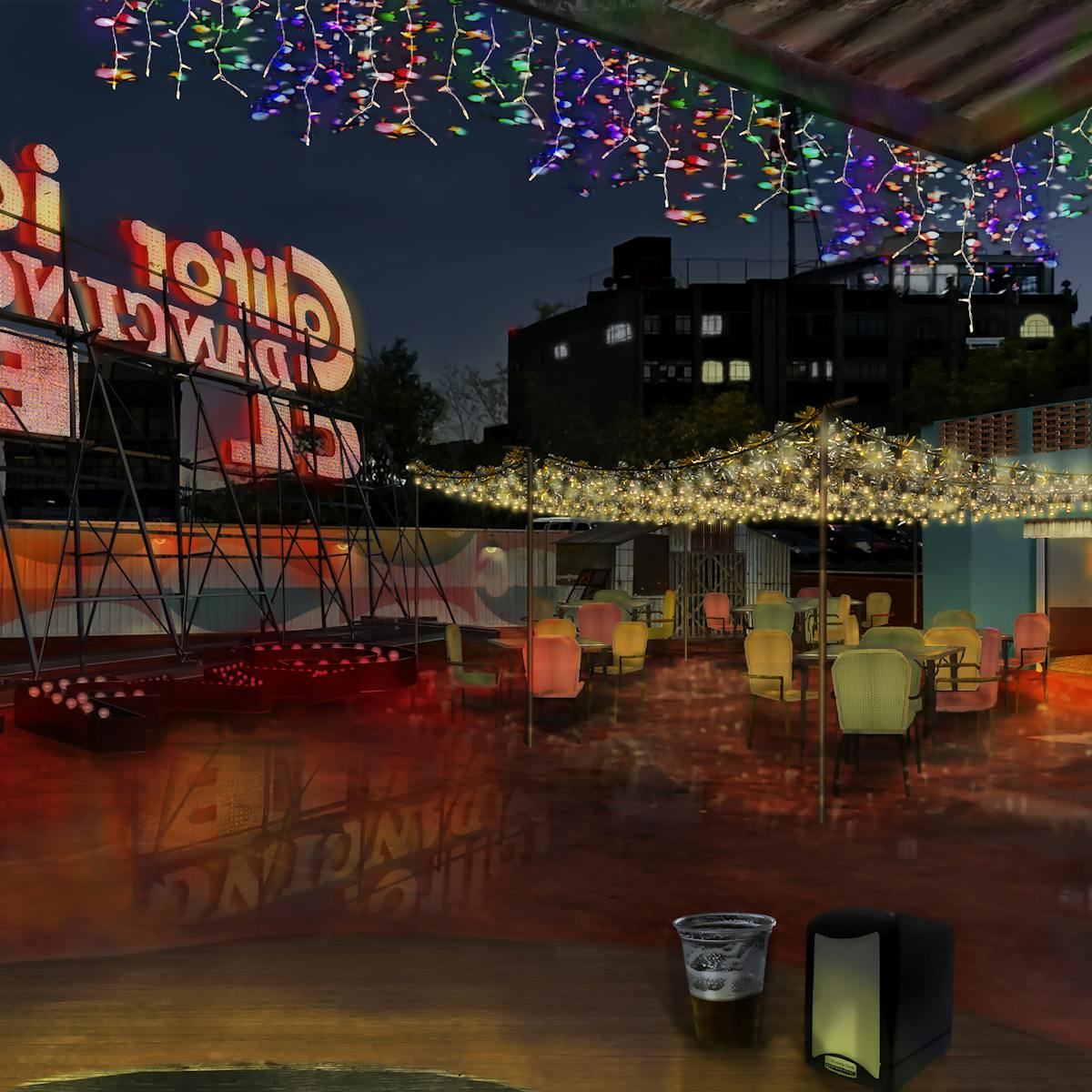A guide to the literary, geographical, and cinematic references throughout Alejandro González Iñárritu's existential Mexican drama.
In BARDO, False Chronicle of a Handful of Truths, Mexican director Alejandro González Iñárritu has crafted a visual spectacle that stems from the main character’s delirium. It is a personal odyssey, but it is also a dream about a country that always seems to be at odds with its own memory. Iñárritu populates the film with references, symbols, and nods to the history and culture of both Mexico City and the nation itself. He leaves small messages, sometimes hidden, sometimes not, which shine a light on the filmmaker’s influences while bringing up the past of a territory that has multiple identities.
We’ve assembled a chronological guide to some of the most important references found in the journey of journalist Silverio Gama for you to follow along as you watch the movie on Netflix.
The Title
00:06:30
It’s long been established that the first word in the film’s title (bardo, both in English and Spanish) is a Buddhist term used to refer to a transitional state. But there is a second meaning that is worth mentioning in this guide. The word in English is bard (barda or bardo in Spanish), and these were the early poets who traveled from town to town narrating stories and heroic deeds of the past. In a world without the written word, their tales were spoken history, fluid and ever-changing. Mexico is still a profoundly oral country, one of legends that mutate every time they are retold. Iñárritu’s film does not stand far from this tradition of the malleability of the past and the epics of heroes that return to their homeland (like Ulysses in the Odyssey) to face mirages.
The Amphibian with the Eternal Smile
00:06:50
Silverio (Daniel Giménez Cacho) is sitting on board an urban train. His hands are holding a bag filled with air and water in which three pink curious amphibians swim around. Axolotls are a species native to Mexico and they possess a characteristic that makes them fascinating: They have the power to maintain their tadpole-like features into adulthood. These aquatic creatures, who can reproduce without ever becoming adult salamanders, live their life in eternal youth, which is why, for decades, they’ve been used to build allegories about intermediate states, Mexican identity, and its permanent transition into so-called modernity. They have been cast as representatives of the past, melancholy, and loneliness, so their presence here underlines the limbo in which Silverio finds himself. It is also an early indication of the filmmaker’s intention to dig into what it means to be Mexican.
The Big Buy
00:06:50
Silverio awakens in his apartment in Mexico City to a strange bit of news on the radio: Amazon, Jeff Bezos’s empire, wants to buy the state of Baja California. Not only that, he has the support of the American and Mexican governments. It is a humorous jab at an instance in Mexican history that still weighs heavily today. Back in 1848, the country lost more than half of its territory to the United States in a deal that managed to end the Mexican-American War. Mexico only received 15 million pesos in compensation, as Silverio points out during a trip to the next item in this list.
Chapultepec Castle
00:09:28
Silverio has a meeting with the American ambassador at this iconic place in Mexico City, a castle built in the eighteenth century on a hill (“the hill of crickets,” according to its original Nahuatl name, Chapultepec), which had been home to viceroys, emperors, and presidents until it was transformed into a museum in 1944.
With a little bit of irony, Iñárritu pits Silverio and the ambassador in a battle of strengths at the same palace that served as a fortress against the American invasion on September 12 and 13 in 1847. It was a battle lost for Mexico, but one which gave birth to the myth of the so-called “Boy Heroes” (Niños Héroes), which Silverio begins to tell. They have been documented by historians as students at the military school who decided to stay and fight to defend their position. Tradition, on the other hand, mainly encouraged by the state, remembers them as tragic, sacrificial figures. One of them, Juan Escutia, is even said to have rescued the Mexican flag and wrapped himself in it before leaping from the top of a tower (though this has been disputed by historians). This is the moment we see at the end of the scene, which was recreated in a parking lot in another part of the city due to the filming restrictions on this historic site.
Welcome to Televisa
00:18:07
Silverio wanders the soundstages of a television studio where he’s about to be interviewed. He walks, as if intoxicated, through the loud sets of a variety show; a musical revue filled with showgirls and rumberas (Mexican rumba dancers); stops by a vintage dressing room; and finally, sits on-air on a talk show that is reminiscent of a roman circus. Every Mexican watching this scene will recognize the television network that has shaped (many would say hijacked) the Mexican collective imaginary. Televisa, the country’s main television network, is synonymous with hegemony; it is the system. Always close to the powers-at-be and the elite, it is also where countless actors, directors, and other film talents have found their first gigs and business opportunities. Iñárritu began his career as a filmmaker in advertising, working closely with the television network and directing commercials that are still iconic today. This was after he helped revolutionize radio for modern audiences as the director of W.F.M. station, which is owned by Televisa. The interview scene allows Iñárritu to explore the biting questions from his own conscience, in the form of interviewer Luis Valdivia, who makes fun of Silverio’s capitalist beginnings.
Julio Cortázar’s Axolotl
00:40:15
Inspired by the architecture of the 1930s and specifically the buildings in La Condesa, a trendy neighborhood in Mexico City, the apartment where Silverio and his wife Lucía chase each other playfully is filled with books on couches, tables, and bookshelves. Throughout the film one can identify works and authors, like Octavio Paz and Jorge Luis Borges, that the filmmaker has mentioned as influences. But there is also a literary reference hidden in the water tank in Silverio’s son’s bedroom. The way in which the camera frames our protagonist, leaning over to see its aquatic inhabitants, stands as a wink to Axolotl, a famous fantasy story by Julio Cortázar, in which a young man is so obsessed with the Peter Pan-like creatures that he ends up switching places with one of them: He becomes an axolotl in the tank.
Production designer Eugenio Caballero decorated the tank with a small Aztec temple, which shares its spot with a small model of the modern Torre Latinoamericana, an icon of the city, as if the water had the power to fuse together two different eras.
California Dancing Club
01:03:00
The party that the journalists’ guild throws in honor of Silverio takes place in this emblematic dancing hall, commonly known as “El Califas,” which opened its doors in 1954. The club has existed in two different millennia, it has survived major earthquakes and a pandemic, and welcomed several generations of dancers without serving an ounce of alcohol (the place is alcohol-free to maintain a wholesome and family-friendly atmosphere). Filming BARDO there is also a wink to the beginnings of the building because it used to be a movie theater before being transformed into a dancing venue. Now the space is transformed once more. According to production designer Caballero, his team reconfigured the interior to allow for cinematographer Darius Khondji’s long takes. For his work on the film, Khondji has been nominated for an Oscar. The structure of the venue was reinforced, chandeliers were installed, and hundreds of mirrors (which the club decided to keep after production wrapped) were put in place.
Juan Rulfo and His Spirits
01:33:50
Silverio wanders the empty streets of downtown Mexico City. The sunlight creates anthropomorphic shadows and apparitions. We hear ominous footsteps. There is a presence, but it is immaterial. This sequence is an homage to the literature of Juan Rulfo which is filled with ghosts, and whose novel, Pedro Páramo, is considered the pinnacle of Mexican literature.
Bodies That Fall
01:36:57
A woman falls to the ground in front of Silverio. She’s not dead, she’s missing. No one can touch her. Moments later, someone else falls, then another, until Silverio is surrounded by fallen bodies and there’s nothing left but to walk among them. The filmmaker alludes to the crisis of missing persons in Mexico. This speaks to us about a different state of in-between because being missing is not the same as dying. In a previous scene, Silverio’s son Lorenzo had warned his father of the absurdity of romanticizing, as an artist and as a Mexican, a country that is also an inferno. In the background, this time in full-size, we can see the Torre Latinoamericana and above it an army general surrounded by flags, a stand-in for the militarization of the country which has done nothing but worsen the violence.
Zócalo
01:42:08
In an unexpected wink at his feature film debut, Amores perros, three street dogs follow Silverio as he makes his way to the main square at the center of Mexico City, the Zócalo or Plaza de la Constitución. It was near this place, now surrounded by the symbols of the country’s religious and political powers (the National Palace and the Cathedral), that Aztec emperor Moctezuma met with the Spaniard Hernán Cortés in 1519. This is where the Spanish colonization of Mexico began. As he arrives, Silverio sees an agonizing stone giant. It is Centéotl, the Aztec god of maize.
Octavio Paz and Hernán Cortés
01:44:33
“Ideas ate the deities!” Hernán Cortés screams suddenly, on top of a pyramid of Aztec bodies. His words come from the poem “Petrificada petrificante” by Paz, possibly Mexico’s most canonical writer when it comes to reflecting on Mexican identity. His verses are, just like BARDO, a succession of images that flow together to create a discourse. In his book, The Labyrinth of Solitude, Paz wrote an entire essay on what it means to be Mexican, but in “Petrificada petrificante” he makes us feel the dirt, the stone, and the rawness of this period of conquest. Silverio and Hernán have a conversation at the top of the structure made of people and the message is so clear it’s barely a metaphor. Mexico, a country that still hurts from the wounds of colonialism, was built on the bodies of indigenous peoples.
Elena Garro
02:08:43
Back in Los Angeles, Silverio and his family enter their home and a particular book with a blue cover is immediately visible on a glass table. It is The Memories of the Future, by Elena Garro, possibly one of the least mentioned references in conversations about the movie. Her presence here is not gratuitous, as she is considered a precursor to the Latin American magical realism movement that made her male peers famous around the world. She, on the other hand, was condemned to oblivion for being controversial at a time when this was not allowed for any woman, no matter how brilliant. BARDO invokes her and her limitless imagination very much on purpose, for her abilities as a poet and her toying with time and space.
The Desert
02:08:43
We’re back in the desert, where everything began. Silverio floats above an arid, dusty landscape. He finds himself in the truest bardo of all: the infinite dry plains that surround migrants on their way to the United States, an odyssey that Silverio, as a “first class” migrant, never had to face. Some will reach their destination; others will remain here forever.



